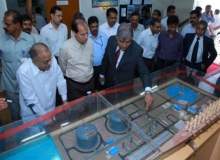
Petronet LNG has built a liquefied natural gas (LNG) receiving, storage and regasification terminal in Kochi, Kerala, India. The terminal was developed on a 40ha site in the Puthuvype special economic zone at an estimated cost of Rs45bn ($700m).
The Kochi terminal is India’s fourth LNG terminal, with a capacity of five million tonnes per annum. It is currently the biggest facility of its kind in India and the first to be built in south India.
Mechanical completion of the terminal was achieved by the end of 2012. The LNG facility was commissioned in August 2013 and officially inaugurated in January 2014.
The first reloading operation to take place at an LNG storage and reloading facility in South Asia was successfully conducted at the site in January 2015. Kochi LNG terminal’s first delivery of LNG from a bunker to small ships was carried out in February 2015.
The terminal satisfies the huge demand for natural gas from various industries in South India, including power, fertilisers and petrochemicals. It also transports LNG via road tankers to various consumers in the region.
The terminal’s development provided huge benefits to the state of Kerala, which has historically been heavily dependent on hydro power for its electricity needs.
Gas-based plants were previously operating at less than 60% capacity due to shortage of natural gas supply. The Kochi terminal addressed this problem by supplying gas to these plants, bridging the gap between electricity demand and available supply.
Delays
The project was originally conceived in the early 1990s but experienced delays due to the lack of supply contracts. Initial construction works for the terminal started in July 2007 but these were also later delayed due to an increase in construction costs.
Higher piling work was required for the storage tanks, while the cost of steel and other construction materials also increased.
The project was resumed in March 2008.
Facilities of Kochi LNG Terminal
The initial design capacity of the terminal was 2.5 metric tonnes per annum (mtpa). Petronet announced its decision to double the capacity of the terminal to 5mtpa in October 2011.
The terminal includes two LNG storage tanks with a capacity of 160,000m3 each, a boil-off gas recovery unit, unloading and vapour return arms and in-tank pumps. Gas vaporisation, transmission and unloading equipment, send-out and regasification facilities, related utilities and offsite facilities have also been built at the terminal.
Other facilities include metering units, gas turbine generators, air heaters, cold recovery units and condensate water storage units.
The terminal’s marine facilities are able to handle LNG tankers with capacities ranging between 65,000m3 and 216,000m3. They include a 320m jetty, berthing / unberthing and mooring / unmooring facilities. A captive power plant is also part of the terminal.
In addition, the site will feature a 1,156km pipeline to supply the gas to consumers. The pipeline network is being laid by the Gas Authority of India Limited (GAIL).
Construction
Construction of the terminal was carried out in three packages, which included the LNG storage tanks, marine facilities and regasification facilities respectively.
The pipeline is being built in two phases. GAIL completed the first phase of the pipeline in September 2012, which covers a 43km stretch from the LNG terminal to the main industrial centres in the city. The second phase will extend the network to Mangalore and Bangalore, and is expected to be completed by December 2018.
Supply contracts awarded
Gas is being imported from countries such as Australia and Qatar. Petronet signed a contract to receive gas from Australia’s Gorgon gas project for a period of 20 years.
Partners and contractors
Petronet is a joint venture (JV) formed by the Oil and Natural Gas Corporation, Gas Authority of India Limited (GAIL), Indian Oil Corporation and Bharat Petroleum Corporation Limited.
Gas imported at the terminal is being marketed by the JV partners in the states of Kerala, Tamil Nadu and Karnataka.
GAIL is also installing a pipeline to supply the gas to consumers.
Japan-based Ishikawajima-Harima Heavy Industries was awarded the engineering, procurement and construction (EPC) contract for the storage tanks.
Afcons Infrastructure was awarded the EPC deal for the marine facilities, while the contract for the regasification facilities was awarded to the CTCI Corporation of Taiwan.
Project management consultancy services were provided by Whessoe.
Rai’s Coastal Survey & Consultancy Services carried out a preliminary bathymetry survey for the project.
Lanier Wallingford International carried out the conceptual design review of the terminal and developed the design for the marine facilities.
Ampo Valves was contracted to supply cryogenic ball, gate, globe and check valves for the terminal.

